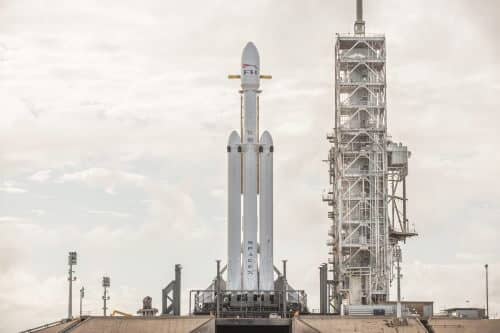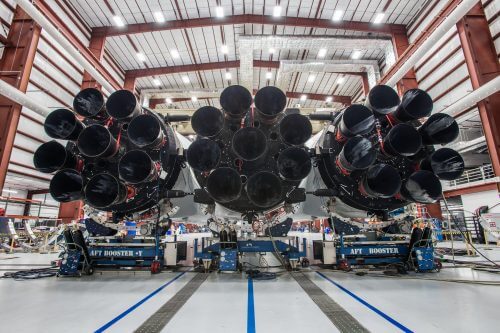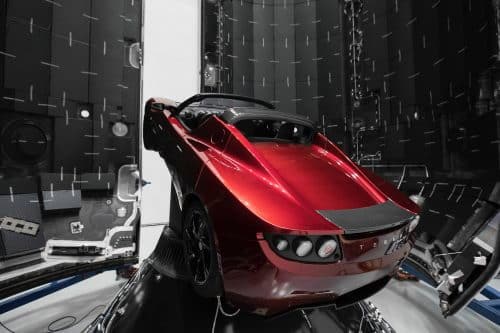Yesterday, SpaceX completed an important milestone before the maiden flight of the world's most powerful launcher - an experiment in which, for the first time, the heavy Falcon's 27 engines were ignited together, when the launch was therefore tightened at the Kennedy Space Center. Elon Musk confirmed that the experiment was successful and wrote: "It will be launched in about a week." In the upcoming maiden flight, Musk's private car will be launched into deep space, and will reach the distance of Mars from the Sun.
The president of SpaceX and its chief operating officer, Gavin Schwettel, said recently that the heavy Falcon is a "beast of a vehicle". Indeed, the company's new launcher, which consists of a Falcon 9 first stage with two additional first stages used as side boosters, has 27 rocket engines (9 per first stage) – more engines than any other American launcher in history. According to SpaceX, the maximum thrust that these engines will be able to create together is equal to that of 18 Boeing 747 aircraft, and they will make the heavy Falcon to the most powerful active launcher in the world (if launched successfully).
Yesterday (Wednesday), "the beast" came to life for the first time: the company tested, at 12:30 EST, the joint operation of the launcher's 27 engines. The experiment was carried out on launch pad 39A at the Kennedy Space Center in Florida, where in the past Apollo pilots were launched to the moon and the space shuttles, and today the company leases it from NASA.
Elon Musk, founder and CEO of SpaceX, confirmed in a tweet on his Twitter page Because the test was successful, and he said that the company intends to make the maiden flight of the launcher in "about a week".
Falcon Heavy hold-down firing this morning was good. Generated quite a thunderhead of steam. Launching in a week or so. pic.twitter.com/npaqatbNir
- Elon Musk (@elonmusk) January 24, 2018
Critical static test
A static combustion test is a routine procedure performed by SpaceX before each of its launches. The experiment is used as a "dress rehearsal" before the actual launch. This time it had a particularly high importance, since it was the first time that all 27 rocket engines of the type "Merlin". The company did perform static combustion experiments last year for each of the first three stages, but separately and not as all three connected to each other.
As part of the experiment, the launcher was transported and lifted, so the launch was carried out using the company's TEL vehicle (transporter/erector/launcher), ignited and eventually its engines were activated for a few seconds, with the vehicle securely fastened to the ground.
Such experiments usually do not attract much attention, especially for a company with a high launch rate like SpaceX, but that does not mean that they are without risk. The best example of this is, of course, The explosion of the Falcon 9 During refueling for such an experiment in September 2016, which resulted in the destruction of the Israeli communication satellite Amos 6.
My raw video of the #SpaceX Falcon Heavy static-fire at Kennedy Space Center. Come for the cloud plumes, stay for the sound.
A French space reporter just yelled "It's like the 4th of July!" pic.twitter.com/vJssukqgIz
— Robin Seemangal (@nova_road) January 24, 2018
The engines were fired in pairs with differences of several milliseconds, according to Report on the NASASpaceFlight website. This method, which was also used by the space shuttle engines, was designed to prevent the forces generated during combustion from damaging the structure of the "Octave” of each first stage, in which eight engines are arranged in a circle around one central engine.
Unlike normal static combustion experiments in the Falcon 9, which usually last between 3 and 6 seconds, this time the experiment continued Almost 12 seconds - the longest time for a static combustion experiment performed by the company (the video published by the company and shown at the top of the news is edited, so the combustion appears shorter in it).
The long way of the heavy Falcon is therefore the launch
The road to yesterday's test was long - the company worked on the development of the heavy Falcon for at least seven years, when Elon Musk announced its development in 2011. The giant vehicle was supposed to be launched for the first time in 2013, but as time passed, the launch target was postponed again and again.

Musk previously noted Because the development of the launcher was much more difficult than it and the company's engineers thought at first: "At first, it sounds very easy: just attach two first stages [of the Falcon 9] as side boosters. How hard will it be?" Musk said. "But then everything changes. All the loads change, the aerodynamics change completely, and the vibrations and the acoustics are tripled."
Last year the company finally began to show significant progress toward the launcher's maiden flight, including the separate static combustion tests of its first three stages. The two side boosters, by the way, are used Falcon 9 first stages.
The company also worked over the last year on adapting launch pad 39A at the Kennedy Space Center to the needs of the Falcon Heavy. It had to do the adjustment work from launch to launch, because its second launch on the US East Coast, SLC-40 at Cape Canaveral Air Force Base (near the Kennedy Space Center), was badly damaged in the explosion of the Falcon 9 (and the Amos 6 satellite) in September 2016, And it also underwent renovations at the same time.

After the completion of the adjustment works, the Falcon 9 was transported to the launch and lifted on it for the first time at the end of last December, in order to perform initial adjustment tests. The company tried several times during this month to perform the static combustion test, but it was postponed due to the need to perform additional tests on the vehicle and ensure that the test will pass successfully. The shutdown of the American government also did not help, and if it had continued, yesterday's experiment probably could not have been carried out.
The next step: launching Musk's private car to Mars
The successful test yesterday is an important step on the way to the first test flight of the heavy Falcon. If the launcher takes off from the launch pad and reaches space, it will launch a wonderful dummy charge, some would say rather flamboyant - Elon Musk's private Tesla Roadster (As you know, he is also the founder and CEO of the electric car company). The car is expected to be launched into an orbit around the sun, which will bring it within a distance of Mars from the sun, but not to Mars itself.

Not only the cargo will be fascinating, but also the launch itself, during which three first stages are predicted at once to land for reuse - two on land and one at sea.
The launch will begin when the 27 engines in the first three stages push the launcher into space. The two side stages will detach before the main stage, and land on land pads at Cape Canaveral, while the main first stage will continue to accelerate the upper stage and the payload towards space. After the first stage also completes its role, it will detach from the upper stage and land on a mobile rig in the heart of the Atlantic Ocean. The upper stage will perform the final burn, in which the payload, Musk's Tesla car, will be put into orbit around the sun.
See more on the subject on the science website:
- SpaceX presents for the first time the Falcon Heavy - which will be the most powerful launcher in the world
- Musk's Tesla car is getting ready to launch near Mars
- The space missions of 2018: from the world's most powerful launcher to the successor to the Kepler space telescope
- The secret Zuma satellite launched by SpaceX was apparently lost and burned up in the atmosphere
- 2017: SpaceX's incredible year
- A missile was born: get to know the small satellite launcher "Electron"

2 תגובות
Uzi, you are probably wrong by 3 orders of magnitude. The fuel consumed by one Falcon 9 launch is equivalent to the fuel consumed by 200 cars per year. And it was indeed a heavy falcon, but the burn was for a few seconds.
An experiment probably pollutes more than all the Teslas put together in a year